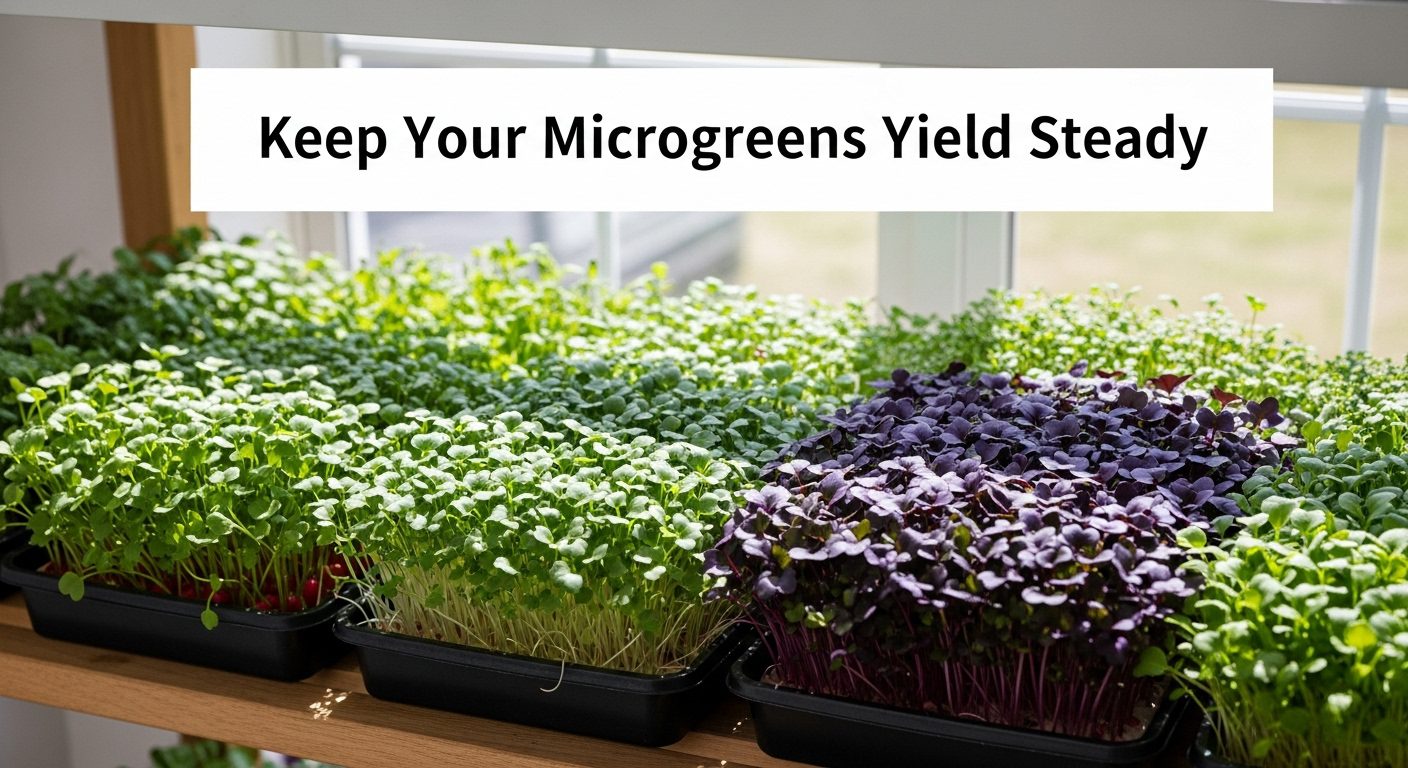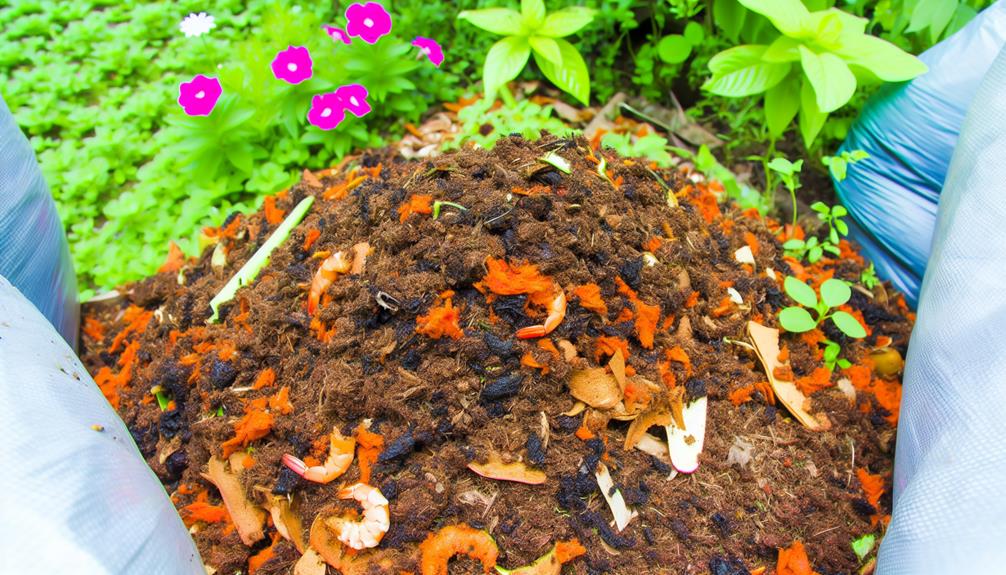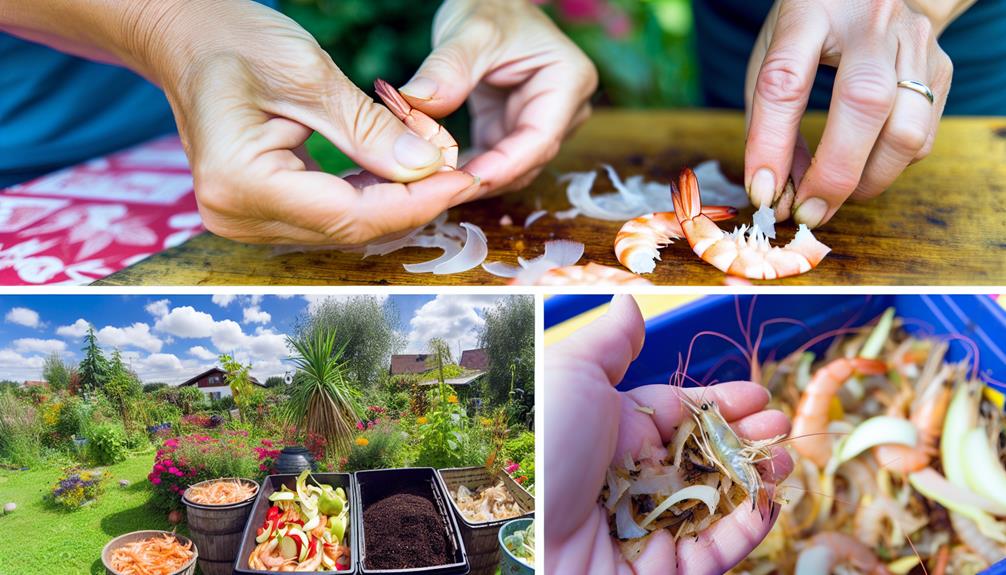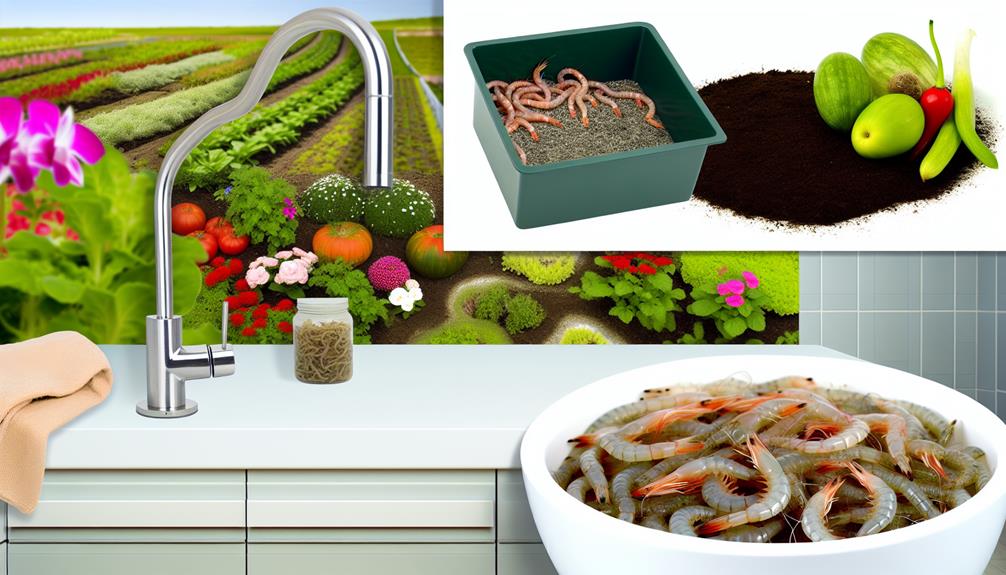

You can definitely compost shrimp shells. They’re rich in calcium, phosphorus, and nitrogen—essential nutrients for your garden. Start by rinsing and drying the shells thoroughly to prevent odors and pests. Chop them into smaller pieces to speed up decomposition. Balance the shells with carbon-rich materials like leaves or paper, aiming for a 2:1 ratio of browns to greens.
Turn your pile regularly for efficient breaking down. Avoid adding too many shells at once to maintain balance. This practice not only enriches your soil but also cuts down on household waste. Keep going to reveal how to make the most of your compost.
Composting shrimp shells enriches your soil with essential nutrients, benefiting your garden’s overall health. By adding shrimp shells to your compost, you’re not just recycling waste; you’re also boosting your garden’s vitality.
One of the primary benefits is the improvement of soil structure. Shrimp shells decompose and break down, creating organic matter that enhances soil aeration and water retention. This means your plants will have better access to the moisture and air they need to thrive.
Another advantage is pest deterrence. Shrimp shells contain chitin, a natural compound that helps deter common garden pests. As the chitin breaks down, it encourages the growth of beneficial microorganisms that combat harmful insects. This natural pest control method reduces your reliance on chemical pesticides, fostering a healthier garden ecosystem.
To start composting shrimp shells, simply rinse them to remove any residual salt or seasoning, then crush them into smaller pieces. This helps them decompose more quickly. Mix them into your compost pile with other organic materials like leaves and vegetable scraps. Over time, your compost will transform into rich, nutrient-dense soil, ready to support your garden’s growth.
Shrimp shells are rich in essential nutrients like calcium, phosphorus, and nitrogen, which are important for plant growth. When you add shrimp shells to your compost, you’re not just recycling waste; you’re enriching your soil with essential elements. These shells have a high chitin content, a natural polymer that boosts the immune system of plants, helping them fight off diseases.
Here’s a quick breakdown of the key nutrients found in shrimp shells:
| Nutrient | Benefit | Amount (Approx.) |
|---|---|---|
| Calcium | Strengthens cell walls | High |
| Phosphorus | Aids in root development | Moderate |
| Nitrogen | Essential for leaf growth | Moderate |
| Chitin | Disease resistance | High |
The calcium levels in shrimp shells are particularly beneficial for ensuring strong plant structures, while the phosphorus is essential for robust root systems. Nitrogen, on the other hand, is a critical component for lush, green foliage. By incorporating shrimp shells into your compost, you create a nutrient-rich environment that supports healthy plant growth.
Also Read: Can You Compost Cat Feces?
Wondering how to get your shrimp shells ready for composting? First, you need to focus on shrimp cleaning. Rinse the shells thoroughly to remove any remaining shrimp meat and other organic material. This step helps guarantee unwanted odors are eliminated and accelerates the decomposition process.

Once your shrimp shells are clean, you’re ready for the next step: shell drying. To dry the shells, spread them out in a single layer on a tray or a baking sheet. Place them in a sunny spot or somewhere with good air circulation. If you’re in a hurry, you can also use an oven set to a low temperature.
Drying the shells guarantees they don’t become a breeding ground for pests and helps them break down more efficiently in your compost pile.
To maintain your compost pile balanced, it’s essential to maintain the right ratio of green to brown materials. Shrimp shells are a great source of nitrogen-rich greens, but you’ll need to add carbon-rich browns like dried leaves or cardboard.
This balance helps avoid odor issues and guarantees efficient decomposition.
Balancing your compost pile’s green and brown materials is crucial for efficient decomposition. Green materials, also known as nitrogen sources, include items like shrimp shells, vegetable scraps, and coffee grounds. These materials provide the necessary proteins and amino acids that microorganisms need to thrive.
On the other hand, brown materials, or carbon sources, include leaves, straw, and cardboard. These materials supply the carbon needed to create energy for the composting microorganisms.
To achieve the right balance, aim for a ratio of about 2:1 browns to greens. This means for every two parts of carbon sources, you should add one part of nitrogen sources. For example, if you have a bucket of shrimp shells, you’ll need roughly two buckets of dried leaves or shredded paper. This balance ensures that your compost pile stays active and breaks down materials efficiently.
Mix your compost materials well to help maintain an even distribution of carbon and nitrogen. Regularly turning your pile will also introduce oxygen, further aiding the decomposition process.
One common challenge in composting shrimp shells is managing odor, but with the right balance of materials, you can keep your compost pile smelling fresh. Proper ventilation and specific composting methods play vital roles in this process.
Begin by making sure your compost pile has a good mix of green (nitrogen-rich) and brown (carbon-rich) materials. Shrimp shells are high in nitrogen, so balance them with carbon-rich items like dry leaves or shredded paper.
Here are some tips to help you maintain a balanced and odor-free compost pile:
Also Read: Can You Compost Wood Scraps?
When composting shrimp shells, make sure to avoid adding too many at once to prevent odor and imbalance in your compost. Proper disposal is crucial to maintain a healthy compost pile.
One common composting myth is that you can just toss in unlimited seafood waste without any repercussions. This isn’t true. Too many shrimp shells can create a foul smell and attract pests.
To avoid these issues, balance your compost by mixing shrimp shells with plenty of carbon-rich materials like leaves, newspaper, or straw. Chop the shells into smaller pieces to speed up the decomposition process. Aerate your compost regularly to keep it oxygenated, which helps break down the shrimp shells more efficiently.
Remember not to rely solely on shrimp shells for your compost’s nitrogen content. Diversify with other nitrogen sources like vegetable scraps and coffee grounds. This prevents nutrient imbalances and promotes a richer compost.
Lastly, be patient. Shrimp shells take longer to decompose than some other organic materials. By following these tips, you’ll make sure your compost is nutrient-rich and ready for future gardening projects.
Join the community of composters who turn kitchen waste into gardening gold!
Once your shrimp shell compost is ready, you can enrich your garden soil by mixing it in to boost plant health.
This finished compost provides essential nutrients, improving soil structure and fertility.
Finished compost from shrimp shells is a fantastic way to enrich your garden soil, providing essential nutrients and improving soil structure. When you add this compost to your garden, you’re introducing a powerhouse of benefits that help create a thriving ecosystem.
First, shrimp shell compost is rich in chitin, a natural compound that supports soil microbes. These microbes break down organic matter, making nutrients more available to your plants.
Second, the compost improves soil texture, aiding in water retention and aeration.
Third, it offers a slow-release source of nitrogen, phosphorus, and calcium, essential for plant growth.
Lastly, combining shrimp shell compost with worm castings can amplify its benefits, as worm castings are packed with beneficial bacteria and nutrients.
To use this compost, simply mix it into your garden soil at a ratio of about 20% compost to 80% soil. This guarantees even distribution of nutrients and supports healthy plant roots.
By incorporating shrimp shell compost into your garden, you’re not only enriching the soil but also greatly boosting plant health. Shrimp shells are rich in chitin, a natural polymer that helps improve soil fertility and enhances plant resilience. When you mix this compost into your garden soil, you’re adding valuable nutrients like nitrogen, phosphorus, and calcium, which are crucial for plant growth.
To use shrimp shell compost effectively, simply spread a layer of the finished compost around the base of your plants. This method guarantees that the nutrients are readily available to the root systems, promoting healthier and stronger plants. Additionally, chitin in the compost stimulates beneficial microbial activity in the soil, further enhancing its fertility and structure.
Another tip is to incorporate the compost into the top few inches of soil when preparing your garden beds. This helps integrate the nutrients more thoroughly, supporting robust root development and overall plant health. As your plants grow, you’ll notice them becoming more resilient to pests and diseases, thanks to the improved soil conditions created by the shrimp shell compost.
Using shrimp shell compost is a fantastic way to reduce your household waste output while enriching your garden soil. By incorporating shrimp shells into your compost, you’re not just improving plant health, but also contributing to important environmental goals like ocean pollution prevention and landfill reduction.
When you use finished shrimp shell compost, you can:
To get started, simply collect your shrimp shells and add them to your compost bin along with other organic waste. Over time, the shells will break down and transform into nutrient-rich compost. Make sure to maintain a balanced compost mixture by adding greens (like vegetable scraps) and browns (like leaves and paper).
Also Read: Can You Compost Blood?
If composting shrimp shells isn’t feasible for you, there are several alternative methods to explore for repurposing this seafood waste. One popular option is to use shrimp shells in crafts. These shells can be cleaned, dried, and used in various DIY projects, such as creating decorative ornaments or jewelry. Shrimp shell crafts allow you to get creative while reducing waste.

Another excellent alternative is making shrimp shell broth. By simmering the shells with water, vegetables, and seasonings, you can create a rich, flavorful broth that adds depth to soups, stews, and risottos. This method not only minimizes waste but also enhances your culinary creations.
For those interested in gardening, shrimp shells can be used as a natural fertilizer. Crush the shells and mix them into your garden soil. They slowly release nutrients like calcium and chitin, promoting healthy plant growth.
Additionally, you can use shrimp shells to make chitosan, a natural polymer with various applications, including water purification and wound dressings. While this process may require more effort, it’s a rewarding way to turn waste into a valuable resource.
Yes, shrimp shells can attract pests in a compost pile. For pest prevention, bury them deep and mix well. This helps minimize compost pests and keeps your compost community thriving and pest-free.
You can definitely compost shrimp shells in a small indoor composter. Shrimp shell nutrients boost your compost. Use indoor composting methods like bokashi or vermicomposting to manage odors and guarantee your community-focused composting journey stays pest-free.
Yes, odors can arise when composting shrimp shells. To manage odors, guarantee proper aeration by regularly turning your compost. This helps the shrimp shells break down faster and keeps your composting community smelling fresh and pleasant.
Shrimp shells take about six months to decompose in compost. Their decomposition rate varies based on conditions, but they enrich your compost with valuable nutrient content, making your garden thrive. You’re contributing to a healthier, sustainable community.
In cold weather, you’ll encounter composting challenges with shrimp shells, but it’s possible. Just make sure your compost heap is well-insulated and maintained. Together, we can tackle these challenges and create nutrient-rich compost even in colder climates.
Incorporating shrimp shells into your compost can greatly enhance its nutrient value. Make sure to crush the shells, balance your compost pile with greens and browns, and regularly turn it for aeration.
Avoid adding too many shells at once to prevent odor issues. Once your compost is ready, use it in your garden to enrich the soil.
If composting isn’t feasible, consider other sustainable disposal methods like using them as garden mulch.
